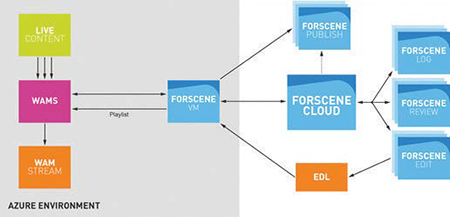Believe It or Not, You Are Cloud-Ready
TORONTO—Out of all the technologies broadcasters use, cloud has to be the single most confusing. I believe this is due to the nature of cloud itself. More than a decade ago, all signal flow diagrams featured a cloud representing a type of remote transport mechanism that magically delivered content into and from our plants.
The magic has continued, as cloud has now become synonymous with offsite services, remote computing and a way to leverage the Internet to save money.
What many broadcasters don’t realize is that as they gradually move into an IT-based environment, they are actually now running their own private cloud services which puts them in a position to interact with other remote cloud services in a seamless manner.

Stan MooteGOODBYE TO TAPE
Take ingest and playout as an example. Tape-based activities have pretty much disappeared, especially after the 2011 Japanese tsunami caused sources of tape to suddenly become scarce. The whole ingest-edit-playout analogy is now completely based on computer hardware, with only a tiny portion being custom SDI I/O modules. These systems are essentially your own private clouds, with controlled inputs, outputs and clearly-defined functions and capabilities.
So what is the difference between your current playout cloud and cloud services? Besides the fact that your playout cloud is deterministic (meaning you can precisely handle live switching), your playout system isn’t scalable. For example, your station may suddenly decide to bring up another service, be it a dot two/three channel on your multiplex, a streaming service or additional cable/satellite channel. To do this, you need more video server capacity along with more general processing and switching gear. This takes time to plan, order, install and test. In a true cloud scenario, adding a new service or channel should be almost instantaneous and seamless; no new equipment, no extra rack space, no new software licenses, just a simple request for additional cloud capacity is all that will be required.
Here is the magic. As our plants moved into the IT realm, this has positioned us into being cloud-capable. Files and streams can be moved directly from playout servers into cloud services for editing, playout, processing, transcoding, collaborative sessions, graphics, private viewing, approvals, news services, Internet channels, social media, live streams and also handling tasks such as adding in closed captions.
BREAKING DOWN SILOS
So what if you are not ready to jump straight into trusting a cloud service? Take a look around your operation. You will see how dependent you already are on cloud services for email, search engines, remote archives, newswire, ad sales and delivery, DRM and pretty much all aspects of web and social media. The reason this isn’t acknowledged is due to the siloed nature of broadcast operations. IT and cloud services represent both the capability and reason to break down these operational silos and operate more efficiently.
The professional video industry's #1 source for news, trends and product and tech information. Sign up below.

As an example of a cloud-based third-party production tool, Forscene provides a virtualized process that can be integrated seamlessly with the broadcast workflow, saving time and money and providing real scalability. Sports is a perfect example. On the Internet, people can watch the broadcast feed along with many other camera feeds, slow-motion outputs, stats info and melts in an instant. These are typically considered as single, separate elements, each requiring their own media. Then there is the whole social media aspect of handling feeds for Twitter, Facebook and countless others.
Realizing the potential income from digital content distribution, many sports rights holders now split the licensing for broadcast and digital rights content. On the production side, budgets in digital rights are a fraction of those in broadcast, so conventional broadcast production workflows that require traditional broadcast equipment are not a viable solution. By pushing IT-based streams into cloud-based distribution, digital rights content producers have instant access to create subclips and highlights packages and broadcast these streams seconds behind the live action, without the need for any additional hardware.
Windows Azure Media Service (WAMS) is a Platform as a Service (PaaS) cloud offering that ingests media assets, encodes them and provides on-demand streaming. These streams and metadata can be used directly by third party production tools, such as Forscene, making subclips or full highlights packages instantly. Once the clip is complete and the metadata has been edited or added, the sequence is dropped back onto Azure for faster-than-real-time conform and distribution. The entire process is virtualized and integrates seamlessly with the broadcast workflow—which saves time and money and provides real scalability, (Fig. 1).
The key to this operation is getting media into the cloud for live streaming, and using these streams as files and proxies for the rest of the activities on a remote basis, including having rights management tables predefined so there isn’t any worry about delivery content where it isn’t authorized.
A final word about IT and cloud: Make sure the IT people in your organization are trained, and understand broadcast operations, needs and specialized requirements. Taking general broadcast courses like the ones IABM provides (www.theiabm.org), are ideal ways to assure yourself that you can take advantage of cloud services, whether it be testing the waters by using cloud services for disaster recovery and business continuity, or moving 100 percent to cloud in the future.
Stan Moote has worked worldwide in the broadcast industry for over three decades and has a clear understanding of technology combined with a solid business twist. You can see many of Stan’s articles and contact him directly atca.linkedin.com/in/stanmoote.
